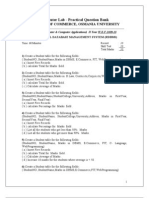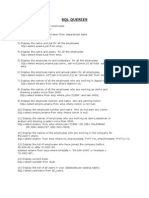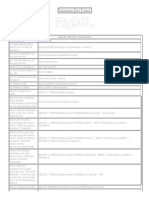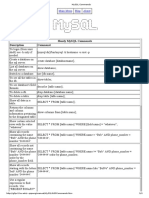MySQL Commands PDF
Uploaded by
Prakash KMySQL Commands PDF
Uploaded by
Prakash K9/11/13
MySQL Commands
Main Menu Blog About
_ _ _ _ _ _ _ _ _ _ _ _ | \ / | _ _ /_ _ _ |/_\ || || \ / ||||\ _ _ _\ ||||| || ||| _ || _ _ _ )|| _ ||| _ _ _ | _ | | _ | \ _ _ ,| _ _ _ _ /\ _ _ \ _ \ _ _ _ _ _ | | _ _ _ /
Handy MySQL Commands Description To login (from unix shell) use -h only if needed. Command [mysql dir]/bin/mysql -h hostname -u root -p
Create a database on create database [databasename]; the sql server. List all databases on the sql server. show databases;
Switch to a database. use [db name]; To see all the tables in show tables; the db. To see database's field formats. To delete a db. To delete a table. Show all data in a table. describe [table name]; drop database [database name]; drop table [table name]; SELECT * FROM [table name];
Returns the columns and column information pertaining show columns from [table name]; to the designated table. Show certain selected rows with the value SELECT * FROM [table name] WHERE [field name] = "whatever"; "whatever". Show all records containing the name "Bob" AND the phone number '3444444'.
SELECT * FROM [table name] WHERE name = "Bob" AND phone_number = '3444444';
g2pc1.bu.edu/~qzpeng/manual/MySQL Commands.htm
1/3
9/11/13
MySQL Commands
Show all records not containing the name "Bob" AND the SELECT * FROM [table name] WHERE name != "Bob" AND phone_number = phone number '3444444' order by phone_number; '3444444' order by the phone_number field. Show all records starting with the letters SELECT * FROM [table name] WHERE name like "Bob%" AND phone_number = 'bob' AND the phone '3444444'; number '3444444'. Use a regular expression to find records. Use "REGEXP BINARY" SELECT * FROM [table name] WHERE rec RLIKE "^a$"; to force casesensitivity. This finds any record beginning with a. Show unique records. SELECT DISTINCT [column name] FROM [table name]; Show selected records sorted in an ascending (asc) or descending (desc). Count rows. Join tables on common columns. Switch to the mysql db. Create a new user. SELECT [col1],[col2] FROM [table name] ORDER BY [col2] DESC; SELECT COUNT(*) FROM [table name]; select lookup.illustrationid, lookup.personid,person.birthday from lookup left join person on lookup.personid=person.personid=statement to join birthday in person table with primary illustration id; INSERT INTO [table name] (Host,User,Password) VALUES('%','user',PASSWORD('password'));
Change a users password.(from unix [mysql dir]/bin/mysqladmin -u root -h hostname.blah.org -p password 'new-password' shell). Change a users password.(from MySQL prompt). Switch to mysql db.Give user privilages for a db. To update info already in a table. SET PASSWORD FOR 'user'@'hostname' = PASSWORD('passwordhere'); INSERT INTO [table name] (Host,Db,User,Select_priv,Insert_priv,Update_priv,Delete_priv,Create_priv,Drop_priv) VALUES ('%','db','user','Y','Y','Y','Y','Y','N'); UPDATE [table name] SET Select_priv = 'Y',Insert_priv = 'Y',Update_priv = 'Y' where [field name] = 'user';
2/3
g2pc1.bu.edu/~qzpeng/manual/MySQL Commands.htm
9/11/13
MySQL Commands
Delete a row(s) from DELETE from [table name] where [field name] = 'whatever'; a table. Update database FLUSH PRIVILEGES; permissions/privilages. Delete a column. alter table [table name] drop column [column name]; Add a new column to alter table [table name] add column [new column name] varchar (20); db. Change column name. alter table [table name] change [old column name] [new column name] varchar (50); Make a unique column so you get no alter table [table name] add unique ([column name]); dupes. Make a column bigger. Delete unique from table. alter table [table name] modify [column name] VARCHAR(3); alter table [table name] drop index [colmn name];
Load a CSV file into LOAD DATA INFILE '/tmp/filename.csv' replace INTO TABLE [table name] FIELDS a table. TERMINATED BY ',' LINES TERMINATED BY '\n' (field1,field2,field3); Dump all databases for backup. Backup file is sql commands to recreate all db's. Dump one database for backup. [mysql dir]/bin/mysqldump -u root -ppassword --opt >/tmp/alldatabases.sql [mysql dir]/bin/mysqldump -u username -ppassword --databases databasename >/tmp/databasename.sql
Dump a table from a [mysql dir]/bin/mysqldump -c -u username -ppassword databasename tablename > database. /tmp/databasename.tablename.sql Restore database (or database table) from [mysql dir]/bin/mysql -u username -ppassword databasename < /tmp/databasename.sql backup. Create Table Example 1. Create Table Example 2. CREATE TABLE [table name] (firstname VARCHAR(20), middleinitial VARCHAR(3), lastname VARCHAR(35),suffix VARCHAR(3), officeid VARCHAR(10),userid VARCHAR(15),username VARCHAR(8),email VARCHAR(35),phone VARCHAR(25), groups VARCHAR(15),datestamp DATE,timestamp time,pgpemail VARCHAR(255)); create table [table name] (personid int(50) not null auto_increment primary key,firstname varchar(35),middlename varchar(50),lastname varchar(50) default 'bato');
g2pc1.bu.edu/~qzpeng/manual/MySQL Commands.htm
3/3
You might also like
- 09-SAMSS-071 - (2016) Qualification Requirements For Inorganic Zinc Primer (APCS-17A) and (APCS-17B)100% (1)09-SAMSS-071 - (2016) Qualification Requirements For Inorganic Zinc Primer (APCS-17A) and (APCS-17B)9 pages
- MySQL Basic SELECT Statement - Exercises, Practice, SolutionNo ratings yetMySQL Basic SELECT Statement - Exercises, Practice, Solution45 pages
- SQL Practice Questions 2 Chapter No 9 SQLNo ratings yetSQL Practice Questions 2 Chapter No 9 SQL7 pages
- CBSE Class 11 Information Practices WorksheetNo ratings yetCBSE Class 11 Information Practices Worksheet3 pages
- MySQL Aggregate Functions and Group by - Exercises, Practice, Solution100% (1)MySQL Aggregate Functions and Group by - Exercises, Practice, Solution35 pages
- Handy Mysql Commands Description Command: Main Menu Blog AboutNo ratings yetHandy Mysql Commands Description Command: Main Menu Blog About2 pages
- Handy Mysql Commands Description Command: Main Menu Blog AboutNo ratings yetHandy Mysql Commands Description Command: Main Menu Blog About3 pages
- Handy Mysql Commands Description Command: Main Menu Blog AboutNo ratings yetHandy Mysql Commands Description Command: Main Menu Blog About1 page
- Handy Mysql Commands Description CommandNo ratings yetHandy Mysql Commands Description Command3 pages
- Handy Mysql Commands Description CommandNo ratings yetHandy Mysql Commands Description Command3 pages
- Commands Description Samples: Joshua B. Posawen IT 223No ratings yetCommands Description Samples: Joshua B. Posawen IT 2234 pages
- By Below Method If Password Is Pass and User Name Is Root # (Mysql Dir) /bin/mysql - H Hostname - U Root - P PassNo ratings yetBy Below Method If Password Is Pass and User Name Is Root # (Mysql Dir) /bin/mysql - H Hostname - U Root - P Pass11 pages
- PHP and Mysql: John Ryan B. Lorca Instructor INo ratings yetPHP and Mysql: John Ryan B. Lorca Instructor I57 pages
- Cosc 2206 Internet Tools: Mysql Database System Installation Overview SQL SummaryNo ratings yetCosc 2206 Internet Tools: Mysql Database System Installation Overview SQL Summary64 pages
- C Palindrome Program, C Program For Palindrome - Programming Simplified PDFNo ratings yetC Palindrome Program, C Program For Palindrome - Programming Simplified PDF4 pages
- ProgrammingKnowledge - C++ Program To Check Palindrome Number PDFNo ratings yetProgrammingKnowledge - C++ Program To Check Palindrome Number PDF1 page
- A Study by Economist Intelligence Unit: Toyota Motor Corporation - A Success StoryNo ratings yetA Study by Economist Intelligence Unit: Toyota Motor Corporation - A Success Story7 pages
- Shriram Life Golden Premier Saver - Website VersionNo ratings yetShriram Life Golden Premier Saver - Website Version21 pages
- Epigenetic Regulation in Plants: Ryza Aditya Priatama (리자 아디티아)No ratings yetEpigenetic Regulation in Plants: Ryza Aditya Priatama (리자 아디티아)30 pages
- 1 Intro Rizal Family Background LWW Rizal 2021No ratings yet1 Intro Rizal Family Background LWW Rizal 202133 pages
- VEC-Delhivery, Bhiwandi Lonad - 20230721No ratings yetVEC-Delhivery, Bhiwandi Lonad - 202307211 page
- Custom DateTimePicker - Custom Controls WinForm C # - RJ Code AdvanceNo ratings yetCustom DateTimePicker - Custom Controls WinForm C # - RJ Code Advance12 pages
- Polyvinylsiloxanes in Dentistry: An Overview: Trends in Biomaterials and Artificial Organs July 2013No ratings yetPolyvinylsiloxanes in Dentistry: An Overview: Trends in Biomaterials and Artificial Organs July 201310 pages
- Appendix B NRTL Parameters and Antoine CoefficientsNo ratings yetAppendix B NRTL Parameters and Antoine Coefficients3 pages
- Zhen-Yu Yin, Pierre-Yves Hicher, Yin-Fu Jin - Practice of Constitutive Modelling For Saturated Soils-Springer Singapore - Springer (2020)No ratings yetZhen-Yu Yin, Pierre-Yves Hicher, Yin-Fu Jin - Practice of Constitutive Modelling For Saturated Soils-Springer Singapore - Springer (2020)417 pages
- Complete Download (eBook PDF) International Economics 12th Edition PDF All Chapters100% (1)Complete Download (eBook PDF) International Economics 12th Edition PDF All Chapters50 pages
- Global VP Engineering Electronics in USA Resume Thirukumar VethanayagamNo ratings yetGlobal VP Engineering Electronics in USA Resume Thirukumar Vethanayagam3 pages
- Big Data Analytics in Mobile Cellular NetworksNo ratings yetBig Data Analytics in Mobile Cellular Networks29 pages
- C264 Application: Modular Remote Terminal UnitNo ratings yetC264 Application: Modular Remote Terminal Unit4 pages
































































































